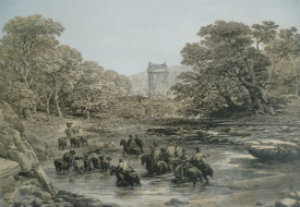Summary | Excerpt | Reviews | Beyond the Book | Read-Alikes | Genres & Themes | Author Bio

This article relates to Fair Helen
In the 14th century, the land on either side of the border between England and Scotland became known as the "Border Country" or "The Borders." This area, where Fair Helen is set, was frequently used as a thoroughfare by English and Scottish armies, and consequently the residents were constantly impoverished as the militias sought to supply themselves from local crops and livestock. The area also suffered from a lack of law and order; defense of property came only with the help from family and so the bonds of the clans were reinforced. Amidst this lawlessness and poverty a new occupation was born: that of reiver. Almost all the male characters in Fair Helen are reivers.
Reiving refers to the plundering or raiding of livestock, although any personal property was fair game. Generally a party of men, numbering 12 to 50, would ride out at night and steal a laird's cattle or sheep under the supposed ethos that all property was common, and so they were really only taking what was theirs. Most raids took place between Lammas, August 1, and Candlemas, February 2.
 These raiding parties were planned like military operations and could last for days. The reivers were heavily armed and dressed for war, too, often wearing a steel "bonnet" and leather jackets lined with steel plates or horn. Their weaponry included swords, daggers, axes, a "lang spear" (akin to a lance), and later, pistols. Their small, sturdy ponies, known as "hobblers," could cover large swaths of difficult ground at high speed, making them especially suited for their task. The escape from the scene of the crime was extremely hazardous as the band could only flee at the pace of the slowest animal.
These raiding parties were planned like military operations and could last for days. The reivers were heavily armed and dressed for war, too, often wearing a steel "bonnet" and leather jackets lined with steel plates or horn. Their weaponry included swords, daggers, axes, a "lang spear" (akin to a lance), and later, pistols. Their small, sturdy ponies, known as "hobblers," could cover large swaths of difficult ground at high speed, making them especially suited for their task. The escape from the scene of the crime was extremely hazardous as the band could only flee at the pace of the slowest animal.
There was also a distinct type of action which could occur at any time of year called the "Hot-Trod," in which revenge was permitted against a clan guilty of reiving as long as the theft had occurred no more than six days prior. This tit-for-tat violence remained common until the early 17th century, when James VI of Scotland added James I of England to his titles. The final straw was a raid by James' Scottish citizens on his newly acquired subjects in Cumbria in the north of England. Adding fuel to the fire was the reivers' statement to the monarchy that with Queen Elizabeth dead, England had no ruler at all until another one was officially crowned, and therefore their actions weren't subject to the law. James issued a proclamation in response to bring order to the region; the term "The Borders" was formally forbidden and the area was renamed "the Middle Shires." In the first year, the crown executed 79 individuals for being rebellious and disorderly, and others were exiled to the far corners of the newly dubbed Great Britain. Residents of the Middle Shires were forbidden to carry weapons or to own a horse worth more than 50 shillings, and those who violated these ordinances were stripped of their land. By the early 1620s, peace was the norm in the region, with reiving being mostly stamped out by the end of the century.
There was no social stigma associated with being a reiver – it was just what one did for a living – and reivers came from every social class; indeed, it was the principal occupation of many Border families. There is some debate as to whether the reivers were bands of daring rogues or more akin to the Sicilian Mafia. Many ballads romanticized their deeds, and Sir Walter Scott further idealized them in his 1802-1803 collection of Border Ballads published as The Minstrelsy of the Scottish Border, which serves as the inspiration for Fair Helen.
Picture of Reivers raid on Gilnockie Tower by G Cattermole
Filed under People, Eras & Events
![]() This "beyond the book article" relates to Fair Helen. It originally ran in January 2016 and has been updated for the
November 2016 paperback edition.
Go to magazine.
This "beyond the book article" relates to Fair Helen. It originally ran in January 2016 and has been updated for the
November 2016 paperback edition.
Go to magazine.






Your guide toexceptional books
BookBrowse seeks out and recommends the best in contemporary fiction and nonfiction—books that not only engage and entertain but also deepen our understanding of ourselves and the world around us.